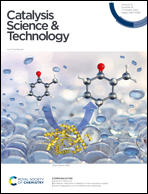Unleashing the solar revolution: harnessing the power of an ultra-strong tensile strength PGTPP nanocomposite photocatalyst for artificial photosynthesis
Abstract
Indeed, natural photocatalysis is a highly promising approach for renewable energy production and the synthesis of cost-effective organic compounds. By mimicking the process of natural photosynthesis, where plants convert sunlight into chemical energy, researchers aim to develop efficient systems that can directly convert sunlight into valuable chemicals. Therefore, herein, we design PVDF-HFP-based high tensile strength solar light harvesting nanocomposite materials for mimicking natural photosynthesis. PVDF-HFP (P) is used as a matrix, without activated Aloe vera-derived graphene (G) and tetra-phenyl-porphyrin (TPP) as reinforcements, which are physically and chemically stacked via π–π bonds. Therefore, we report the different compositions (0.5, 1, and 1.5% of G) based on P@G@TPP nanocomposites i.e.; PGTPP photocatalysts for selective 1,4-NADH/NADPH regeneration under solar light. Among these compositions, the 1% G composition-based designed PGTPP nanocomposite photocatalyst is superior to 0.5, and 1.5% PGTPP nanocomposite photocatalysts due to high tensile strength (12.213 MPa) and better thermal stability. Therefore, the 1% PGTPP nanocomposite photocatalyst has an excellent ability to regenerate 1,4-NADH/NADPH (86.32/97.25% in 2 h) than others. Overall, the result showcases the capabilities and versatility of these P-based nanocomposite materials, highlighting their significance in solar light harvesting, photocatalysis, solar chemical production, and tissue engineering.



 Please wait while we load your content...
Please wait while we load your content...